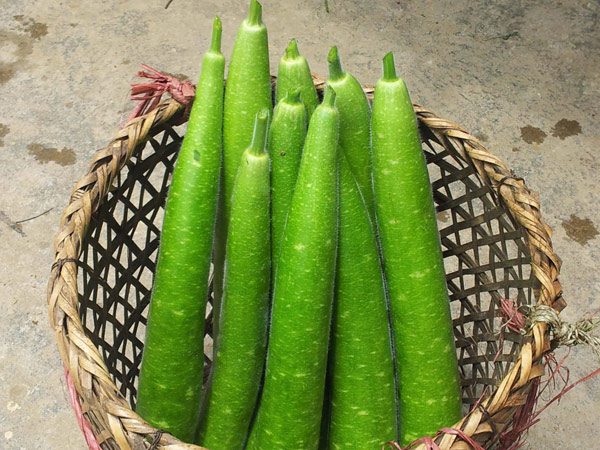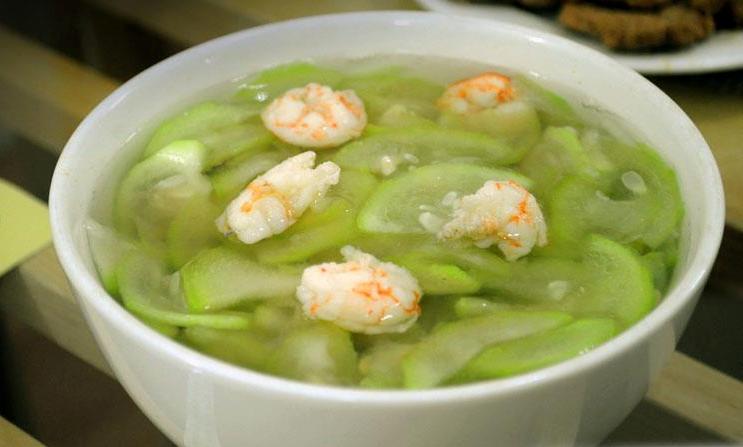Thanks to its relatively simple cultivation technique, the bottle gourd not only provides shade but also serves as an ingredient in many delicious dishes, making it widely grown and used in various regions.
The scientific name of bottle gourd is Lagenaria siceraria (Molina) Standl, belonging to the Cucurbitaceae family, and its cultivation technique is quite simple. Bottle gourd originates from Africa and India and is now widely cultivated in tropical and subtropical countries around the world.

Bottle gourd’s cultivation technique is not difficult, so it is grown in many places.
Bottle gourd is a perennial vine with climbing stems, branching tendrils, and vigorous leaf growth, necessitating topping and support structures during cultivation. Its root system is extensive, spreading widely and capable of producing numerous adventitious roots at the nodes. Pollination occurs through wind and insects. The fruit varies greatly in shape and size, typically cylindrical, measuring 50 – 100 cm in length; when mature, the skin hardens. Bottle gourd thrives in high temperatures ranging from 20-30 degrees Celsius and requires strong light intensity, making it a summer vegetable.

To achieve a fruitful gourd trellis, farmers should follow some basic cultivation techniques.
Currently, there are many varieties of bottle gourd, but primarily four types: round gourd, star gourd, white gourd, and basket gourd. However, in the northern regions, star gourd is preferred for its high yield and stable income.
Bottle gourd can be cultivated year-round, with a higher yield in the dry season than in the rainy season. It grows well when sown from November to January. The seeds require high temperatures and sufficient moisture to germinate.
Cultivation Techniques
Farmers should soak seeds for 10 – 12 hours, then wrap them in hot ash or sand for 4 – 5 days to germinate. After germination, seeds should be sown in soil until the seedlings have two true leaves before transplanting. Alternatively, seeds can be directly sown in the field, with 3 – 4 seeds per hole, digging holes measuring 50 x 50 x 30 cm, spaced 1 meter apart, and applying plenty of compost or decayed grass along with about 100 grams of NPK mixed fertilizer to each hole before planting.
Soil for planting: Bottle gourd can grow well in various soil types, but the best soil is loose, fertile, with a pH around 6 – 7, such as loamy or alluvial soil. If growing bottle gourd in the home garden, mixing soil with a little rice husk, coconut fiber, and animal manure will enhance the nutrient content.
Bottle gourd requires a lot of water, so caretakers should water the plants regularly 1 – 2 times a day to keep the soil moist. Watering frequency should increase when the gourd bears fruit. The growth phase lasts from planting until the gourd reaches the trellis (about 60 days after planting), during which farmers should apply fertilizer weekly to prepare for flowering and fruiting.

The bottle gourd has many health benefits and is widely used.
During the flowering and fruit-setting stage, the plants should be fertilized every 7-10 days with gradually increasing amounts to ensure the fruits are large and plentiful. Throughout the cultivation period (130 – 140 days), each hole should receive 1 – 1.5 kg of NPK mixed fertilizer.
When the gourd reaches a length of 1 meter, farmers should start wrapping the base with soil, covering the nodes every 1 – 2 nodes to encourage the growth of adventitious roots, enhancing nutrient absorption for the fruit. After 2 months of growth, farmers should allow the gourd to climb the trellis, keeping the vine in its natural position without twisting or flipping. Trellis construction should allow ample space for the gourd to climb, which can start flowering and fruiting once it reaches the trellis. Harvesting begins 75 – 90 days after planting.
The gourd produces many branches and bears fruit on the branches. Branches along the main stem from the base to the trellis should be pruned to allow for better air circulation. Once the gourd reaches the trellis, growers should avoid excessive pruning of fruiting branches. After harvesting fruit from a branch, farmers should pinch the tips to promote larger fruit growth and encourage continued fruiting on other branches.
Pests affecting bottle gourd include leaf miner flies (Lyriomyza spp.), aphids (Aphis sp.), and cucumber beetles (Aulacophora similis). Farmers should promptly apply pesticides when these insects appear.

Bottle gourd soup with shrimp is a refreshing summer dish loved by many.
Common diseases affecting bottle gourd include seedling wilt caused by Rhizoctonia solani fungus, viral mosaic disease, anthracnose caused by Colletotrichum lagenarium during the rainy season, and powdery mildew caused by Sphaerotheca fuliginea in the dry season. In reality, due to the small cultivated area and low economic value of bottle gourd, farmers may not apply preventive treatment for diseases, opting instead to remove diseased plants or leaves when necessary.
Harvesting and Seed Preservation
Bottle gourd fruits can be harvested 10 – 12 days after flowering. Farmers should cut the fruits when the skin is still soft, elongated, and the seeds inside are just forming for the best taste. It is advisable not to let the fruits mature too much, as the hard skin will result in a less pleasant flavor and shorten the plant’s lifespan. With proper care, a trellis of 100 plants can yield fruit every 2 – 3 days; each plant averages 10 – 15 fruits.
Uses of Bottle Gourd
The nutritional content of bottle gourd is lower than that of other plants in its family, but the tender flesh is sweet, providing cooling effects, detoxifying properties, and potential benefits for diabetes and skin conditions. The flowers and seeds of bottle gourd are also used in Traditional Chinese Medicine. The mature gourd skin is very hard and is used to make bottles, jars, or household items.
Bottle gourd contains many components beneficial for human health. The fruit can be cooked in soups or stir-fried according to preference, and the young leaves can also be used to make a sweet and flavorful vegetable soup.
Traditionally, homemakers often scoop out the flesh and seeds before preparing dishes. However, nutrition experts suggest that these should only be discarded if the fruit is overripe. This part contains many vitamins and nutrients, and bottle gourd seeds can also help treat worms and headaches. Additionally, for gum inflammation or gum recession, boiling bottle gourd seeds in water can be used as a mouth rinse. The gourd leaves are a common dish featured in many family meals, rich in fiber, helping diners feel full without the fear of weight gain.


















































